How much more use will the play area in your home be getting?
Spring Break and summer vacation are fast approaching. Organizing the toys and keeping the play area tidy will be more challenging than ever! Arts and craft items, puzzles and games with lots of small pieces that get lost. And storing all those Legos!
When my four older children were small, we lived in a 1200 square foot house with one living room. There wasn’t a playroom or family room. The basement was partially finished, and we were able to make a play area there. They could play while I did laundry, but it wasn’t really ideal. It was chilly in the winter, and because it was also where storage and the mechanicals of the house were they had to be well supervised. Since they didn’t have a lot of play space in the main part of the house, there was never a playroom overflowing with toys. And that was a good thing, for them and for me! Trust me, we still had plenty of toys! With four kids, toys were just part of life! Like everything else in a house that size, we only kept what was used and loved.
I have a confession to make.
I am not a big fan of toys, and have always had a love/hate relationship with them. My kids have a box of dress up clothing. They will use a throw blanket as a cape instead. Yes, toys can help keep our children occupied. But let’s face it, most kids aren’t great at picking up toys on their own. At least mine weren’t, despite much prodding! If your kids are, that’s awesome, and I’m jealous! One of my happiest moments as a parent was when we hit the “no more toys’ milestone with my older four children. Of course, then we had our twins and are back into it. Sigh.
I love that my kids can be occupied for a few minutes with their playthings. I hate that they wind up scattered throughout the house, despite my continuing attempts to corral the toys in the playroom. Our playroom sees very little play, and seems to a giant toy storage container. Love that we try to keep a minimal amount of toys, because, lets face it, they are just going to pretend my laundry baskets are pirate ships and my throw blankets are dress-up capes. Hate that I still find toys in every room. Sigh.
Until they outgrow their toys and switch to video games and iPads (and an entirely new battle will begin), we do our best to keep the toys to a minimum and create a home for everything to live in our space. Here are my 6 best toy storage and organization tips:
-
Keep toys to a minimum.
Really. After 6 kids, I learned that when my kids have less toys, they actually play with what they have better. I know that If you walk into your children’s play area and feel overwhelmed by the amount of toys, chances are good your kids are overwhelmed too. They may not be able to express that, but chances are very good they are only playing with a small number of the toys they have at any given time.
-
Use the toy rotation system.
If you (or your kids) might not be ready to part with some toys, take some of their lesser played with things and store them in another space. If you don’t have the room to store toys elsewhere, box them up and put them up high or out of sight i their play area. Every few weeks, switch up lesser used toys for those from storage. if they still go unplayed with, pass them on.
-
Use the right storage.
Large toy boxes are better for larger baby and toddler toys, but small things will get lost on the bottom. Finding the right balance between general categories (vehicles, dolls) and more specific categories (Matchbox cars or trains, LOL dolls or Barbies) can get overwhelming if there are too many different types of toys. Go back to tip #1 and then use the right size bin for the amount of toys in that category. Tall items can be stored upright in taller baskets.
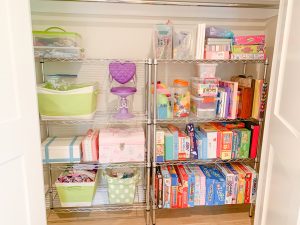
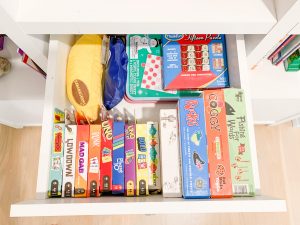
-
File vertically whenever possible.
This can mean standing board game and puzzle boxes upright on a shelf. It can mean ditching the boxes altogether and switching to Ziplock bags (or investing in zippered pouches like these). Those zippered pouches can save space when filed upright into a drawer or bin. Anything that can be stored upright will automatically give your kids more storage and easier access than digging through a stack.
-
Use carts.
I am a big fan of using carts for kid’s toys and art supplies! Kids like to be where the action (and the family) is, and thats not always in their designated play space. Setting up a. moveable cart lets the kids bring their toys or arts and craft supplies to the kitchen or other area. These things can easily be put away when finished. And carts aren’t just for art! I’ve set up carts for video game systems, Play Doh, homework stations for remote school, and Lego building. Whatever your kids are into, a cart can let them set up (and clean up) where they want.
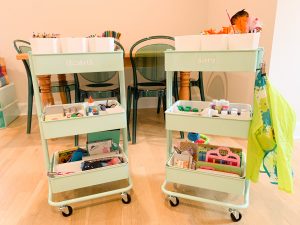
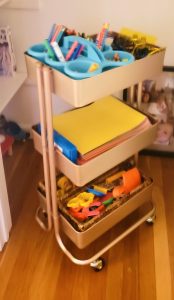
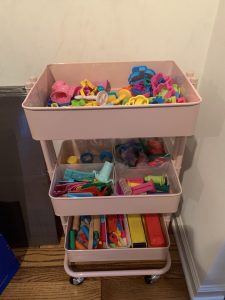
-
Smaller kids need bigger categories.
Trying to microorganize young children’s toys can get frustrating and time consuming. Keep organization categories simple enough for small children to be able to get in the habit of tidying up their toys.

-
Edit frequently, and have your kids help.
Toys need frequent editing. Take out the no longer played with, the broken ones or those missing pieces. Making it a regular chore done with the kids helps them learn this as a skill, and hopefully helps them learn to let go of things they don’t need at an early age. Many kids are happy to let go of toys they don’t play with when they know it will be donated to give another child a chance to play with something they once enjoyed. Sometimes, a toy was a gift or they have a memory associated with it. I have done “photo shoots” of stuffed animals before they were donated. This helped the child be able to keep the memory without keeping the actual item (which they knew they didn’t really want).
A note about labels. I feel it is really personal preference. If you feel they help you and your kids keep toys better organized, by all means use them! Picture labels can help children who are not yet reading know where their toys belong.
